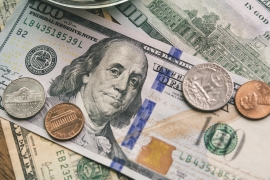Archived article
Please note that tax, investment, pension and ISA rules can change and the information and any views contained in this article may now be inaccurate.

Gold bugs may be getting nervous that they are about to be squashed by a rising dollar, as the precious metal’s price is now trading back below $1,900 an ounce. Precious metal miners Fresnillo, Polymetal, Hochschild and Centamin are all languishing at the bottom of the FTSE 350’s performance today. A bouncy buck is traditionally seen as bad for gold – and other dollar-priced commodities – simply because it makes the metal more expensive for would-be buyers who use another currency, be it the pound, euro, yen, rupee or something else.
Gold peaked at a new all-time high above $2,050 in early August and has since lost 9% of its value, leaving it close to ‘correction’ territory (as defined by a 10% drop from the peak).
Meanwhile the dollar, as benchmarked by the DXY (or ‘Dixie’) index, bottomed in late summer and has since risen from a late-August trough of 92.1 to 94.1.
That seems to have stopped gold in its tracks after its stunning run from barely $1,500 an ounce a year ago.

Source: Refinitiv data
Gold may also be pausing for breath after huge gains – it is still up by 24% in dollar terms over one year and by more than 60% over five – while the US Federal Reserve’s reticence when it comes to more Quantitative Easing could also be a factor. The US central bank has held its total asset base at around $ 7 trillion throughout summer and early autumn and chair Jay Powell has called on Congress for a more expansive fiscal policy to supplement loose monetary policy.
Investors sought out gold as the Fed turned on the printing presses with the first three phases of QE between 2008 and 2012 but then fell out of love with the precious metal even as the central bank’s balance sheet continued to expand. Perhaps this was because the US economy and stock market both seemed to be on an even keel. Gold has come back into its own in the past year, first as the Fed backed away from raising interest rates and sterilising QE after bouts of financial market turbulence in late 2018 and early 2019 and then as the pandemic hit, the US economy tanked and it looked as if the chair Powell and colleagues were chasing the game and not ahead of it.

Source: FRED – St. Louis Federal Reserve database, Refinitiv data
Any sense that the Fed is not entirely in control of the situation may tempt investors back to gold, so a return to QE in response to an unexpected downturn in the US economy could be a trigger for further outperformance from the metal.
As such the investment case for buying gold on the dips will remain intact from the perspective of bulls:
- Central banks will continue to create money through QE and Governments will continue to run ever higher budget deficits, debasing currency through increased supply. By contrast, global gold stocks grow by barely 2% a year.
- Low or zero interest rates mean there is no opportunity loss in terms of yield when it comes to holding gold as an insurance policy.
- Gold is seen as a haven asset and it could do well if financial markets stumble again in the face of the pandemic and it knock-on effect upon the global economy.
Sceptics will stick to their guns by arguing that gold has already had its day in the sun:
- It is nothing more than a pet rock, a barbarous relic, with little industrial use and no yield.
- A vaccine for COVID-19 will reduce the need for protection against the pandemic or a recession, not least be helping to get the economy back on track.
- The dollar is gaining ground after a period of weakness.

Source: Refinitiv data
It may not pay to put too much emphasis on gold’s relationship with the dollar, especially as so few things are as unpredictable as currencies. The gold and the greenback rose in tandem on several occasions between 2009 and 2012 and did so again in 2015-16 and 2018-19. Those periods were all notable for disappointing economic news or financial market dislocations to suggest that gold could still serve as a store of value, in the event of any unexpected future shocks.
Related content
- Wed, 17/04/2024 - 09:52
- Tue, 30/01/2024 - 15:38
- Thu, 11/01/2024 - 14:26
- Thu, 04/01/2024 - 15:13
- Fri, 17/11/2023 - 08:59

